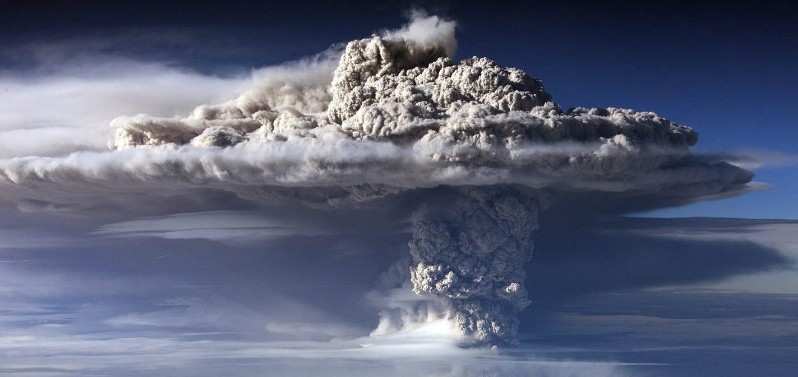One of the greatest mass extinctions caused by volcanic eruptions

Scientists have linked global mass extinction at the Permian-Triassic boundary some 250 million years ago to an ice age caused by the activity of the first volcanism in the Siberian Traps. The research paves the way for a new vision of the Earth's climate history.
The Earth has known several mass extinctions over the course of its history and one of the most important happened at the Permian-Triassic boundary 250 million years ago when over 95% of marine species disappeared. Up until now, scientists have linked this extinction to a significant rise in Earth temperatures, but researchers from the University of Geneva (UNIGE), Switzerland, working alongside the University of Zurich, discovered that this extinction took place during a short ice age which preceded the global climate warming.
It's the first time that the various stages of a mass extinction have been accurately understood and that scientists have been able to assess the major role played by volcanic explosions in these climate processes. This research, which can be read in Scientific Reports, completely calls into question the scientific theories regarding these phenomena, founded on the increase of CO2 in the atmosphere, and paves the way for a new vision of the Earth's climate history.
Teams of researchers led by Professor Urs Schaltegger from the Department of Earth and Environmental Sciences at the Faculty of Science of the UNIGE and by Hugo Bucher, from the University of Zürich, have been working on absolute dating for many years. They work on determining the age of minerals in volcanic ash, which establishes a precise and detailed chronology of the earth's climate evolution.
They became interested in the Permian-Triassic boundary, 250 million years ago, during which one of the greatest mass extinctions ever took place, responsible for the loss of 95% of marine species. How did this happen? For how long marine biodiversity stayed at very low levels?
A technique founded on the radioactive decay of uranium
Researchers worked on sediment layers in the Nanpanjiang basin in southern China. They have the particularity of being extremely well preserved, which allowed for an accurate study of the biodiversity and the climate history of the Permian and the Triassic.
"We made several cross-sections of hundreds of meters of basin sediments and we determined the exact positions of ash beds contained in these marine sediments," explained Björn Baresel, first author of the study.
They then applied a precise dating technique based on natural radioactive decay of uranium, as Urs Schaltegger added: "In the sedimentary cross-sections, we found layers of volcanic ash containing the mineral zircon which incorporates uranium. It has the specificity of decaying into lead over time at a well-known speed. This is why, by measuring the concentrations of uranium and lead, it was possible for us to date a sediment layer to an accuracy of 35 000 years, which is already fairly precise for periods over 250 million years."
Ice is responsible for mass extinction
By dating the various sediment layers, researchers realized that the mass extinction of the Permian-Triassic boundary is represented by a gap in sedimentation, which corresponds to a period when the sea-water level decreased.
The only explanation to this phenomenon is that there was ice, which stored water, and that this ice age which lasted 80 000 years was sufficient to eliminate much of marine life. Scientists from the UNIGE explain the global temperature drop by a stratospheric injection of large amounts of sulphur dioxide reducing the intensity of solar radiation reaching the surface of the earth.
"We therefore have proof that the species disappeared during an ice age caused by the activity of the first volcanism in the Siberian Traps," added Urs Schaltegger. This ice age was followed by the formation of limestone deposits through bacteria, marking the return of life on Earth at more moderate temperatures.
The period of intense climate warming, related to the emplacement of large amounts of basalt of the Siberian Traps and which we previously thought was responsible for the extinction of marine species, in fact, happened 500 000 years after the Permian-Triassic boundary.
This study, therefore shows that climate warming is not the only explanation of global ecological disasters in the past on Earth: it is important to continue analyzing ancient marine sediments to gain a deeper understanding of the Earth's climate system.
Source: Universite de Geneve
Featured image: Puyehue Cordón Caulle eruption in 2011. Credit: EPA

The Permian extinction occurred at the very end of the only other period that planet has pased through during the Phanerozoic which resembled the present in terms of temperature and CO2 impoverishment. A useful reference here is Geocarb III. The Permian had been in an ice house state for for several million yeaats. AND the best geological evidence indicates a severe drop in sea level at the transition between the Permian and Triassic. The only known geological process that could cause that is a glacial epoch. Important to remember here is that atmospheric CO2 had declined from over 25 times present levels around 500 million years ago to approximately present levels by roughly 350 million years ago – 100 million years before the Permian extinction. Atmospheric CO2 levels bottom out over that period – as at present – and it is probable that biological uptake was about equivalent to geological output. That is, things were near an ecological collapse with weak recoveries and losses due to low CO2 affecting primary production. The Siberian Traps, at their best, merely fertilized the end Permian. It is not until after the extinction that CO2 levels begin climbing to their next peak in the mid-Mesozic at around ten times present levels. CO2 levels have again been declining since then and evidence from plant evolution indicates the effects of CO2 impoversihment on Cenozoic biological systems in such things as the spread of C4 and CAMS cycle plants.